Visiting Lancer Systems’ homepage will probably surprise most shooters who know its firearms parts, as the company actually manufactures precision parts for a handful of markets and is fairly large. Their experience in aerospace, carbon fiber and ceramic composites, seals, bearings, offshore drilling rig components, etc, transfers over to the commercially-available firearms and components listed on its webstore. While I have long-since been familiar with Lancer’s L5AWM AR-15 magazines, and have considered them my hands-down favorite since first discovering them, I had never played with Lancer’s other products. That all changed in late 2014, when I picked up one of their dead sexy carbon fiber handguards and an L15 lower receiver. . .
https://www.youtube.com/watch?v=pNJpvC5cjTc
Unfortunately, I’ve been waiting on a new barrel for my 9mm AR-15 for months now, and I haven’t yet had the chance to do more than fondle and stare at the extended length, carbon fiber handguard. It has been slated for this AR build, and will cover the 5.5″ barrel plus all but an inch or so of my Liberty Mystic suppressor. Should look sweet, but it’ll have to be reviewed in the future as a separate gear review.
Now, there are a few ways to get one’s hands on an L15 AR-15 lower receiver. It can be purchased as part of a complete Lancer rifle, or it can be purchased without an upper in various states of build — either ready-to-run, fully assembled with Ergo grip and a couple choices of triggers and stocks, or stripped. At least, as stripped as it can be since two of the parts are proprietary.
Lancer’s L15 lower contains an oversized magazine release button, which is a proprietary shape and nicely integrated into the styling of the receiver. It attaches in the normal spot, but it extends downwards to the top of the trigger guard, which does make it easier to reach.
Also residing on the right side, above and to the rear of the mag release, is a bolt release lever. It doesn’t work as a catch, but it’s an effective bolt release that’s easy to reach with the trigger finger of one’s right hand, which is likely already indexed in that very area during a magazine change. For a left-handed shooter, it will allow for dropping the bolt with his or her right hand, which is the mirror image of the standard battery of arms for a righty on a standard rifle. The bolt release on the left size isn’t modified at all for this functionality, so any parts kit or aftermarket piece should still work fine.
In the case of an assembled lower, it ships with a standard safety lever so isn’t ambidextrous there. However, the selector barrel has an indicator notch on the right side and the receiver is engraved with “SAFE” and “FIRE” on the right side as well. Any aftermarket, ambi safety selector will work on the L15 lower.
The ambi bolt release is nice, but the L15’s real trick up its sleeve is interchangeable magazine wells. Lowers, whether assembled or stripped, can be purchased with one of three magazine wells included — standard, tactical, or competition — and all of them are available separately as well. The variable here is the size of the magwell’s flared mouth, with a larger opening assisting in faster, easier magazine insertion.
Mag wells are easy to swap. On the front, a groove in the magwell indexes with a lip on the receiver, and on the back, a standard AR-15 pivot pin holds it securely to the oversized trigger guard.
A spot of foam rubber in the magwell’s front groove ensures there are no rattles.
Before receiving the receiver, I was a little worried that a swappable magazine well could lead to a lip at the transition of magwell to receiver — something the magazine could get caught up on. Not the case here, as fit is very precise and the entire transition from flared to straight happens in each of the magwells.
Considering the L15 receiver’s large deviations from mil-spec standard, I was surprised to find that it’s made from a forging rather than machined from billet. Although I’m not entirely convinced that I should care for my purposes, it has been stated by many smart engineering types that a receiver forged into its near-finished shape is inherently stronger — that is, stronger than one machined from a forged billet — for reasons of metal grain structures following shapes in the receiver. Most notable of these shapes is the threaded flange into which the buffer tube mounts. Although I have never broken one, it’s probably the most common point of failure on a lower.
Forgings come out rough, though, and still need plenty of machining to finish them up. In the case of Lancer’s L15, the magazine well is broached, which is considered more accurate than milling, and the rest of the machining is clean to the point of flawless. It’s smooth and crisp and free of tooling marks. The MIL-A-8625 TYPE III CLASS 2 hard anodizing is even and looks just right. It’s a nice piece.
The more-or-less diamond shape of the carbon fiber stock, which can be purchased on its own, allows for a comfortable and solid cheek weld from either side. It’s a nice departure from a market dominated by round options. On the rear are various provisions for sling mounting, including a steel QD socket insert. Non-adjustable, but available in A1 (10.25″) or A2 (10.8″) length. As you may expect, it doesn’t add much weight to the buffer tube (9.4 oz), although the polymer used at front and rear is extremely dense and feels very strong.
It’s definitely good looking, although I admit to this stuff rekindling my carbon fiber lust, plus having a general preference for fixed stocks — an ACE Skeleton is on my go-to AR, and I have an ACE UltraLight on the way for the soon-to-be-an-SBR CZ Scorpion.
On The Range
I’ve had the L15 for about four months now, and have swapped back and forth between all of the magwells a few times. However, it’s the competition magwell that is on there now and that has spent the most time on the lower, and I doubt it’ll come back off. It looks cool and it’s a lot of fun to use. It also makes a great hand grip for shooters who like to grab the front of the magazine well.
The L15 has been my test platform for AR parts recently, as seen in the Hogue review and the Velocity Triggers review (at least in the video), and it’ll probably pop up in the other trigger tests as well. There are a couple other Ergo grips here, a Strike Industries Ultimate Selector Switch (seen being tested on the lower in the Hogue review photos), and another stock on the way, too, so don’t be surprised to see more of this L15 in the future.
I’m digressing a bit, but this is basically the roundabout way to say that it’s a cool lower to look at and it’s also nice when out shooting with it. I like the size and shape of the trigger guard, I like the swappable magwells and slamming magazines into the tactical and competition ones, I like the larger magazine release button and I have even gotten quite used to using the trigger-finger bolt release, which I find intuitive and fast. It feels like a well-made, high quality piece.
Negatives
Nothing’s perfect, and I do have a couple of L15 nits to pick. As you can see in the photo above, the design of the right side bolt catch leaves minimal room for the front trigger pin. While this is a total non-issue with any standard trigger pin, and works fine with the CMC C-Clip ones seen above, it’s a show stopper for most anti-walk trigger pin kits out there. KNS is a no-go, Elftmann Tactical is a no-go, and I think the bolt heads on most other kits would be too big to fit in the receiver’s pin relief there.
Magpul Gen M3 magazines have a pronounced flange — an overtravel stop — on the back spine of the mag body:
This lip hits the L15’s magwells and prevents full insertion. It’s really darn close, but the the 30- and 40-round mags won’t lock in. The 10-rounder, with its ever so slightly smaller rear flange, does work. This was disappointing but, to Lancer’s credit, it had already designed these magwells before the Magpul Gen3 mags were released, it definitely isn’t the only receiver on the market that has this specific “issue” (see Nick’s review of the Gen M3 mags), and filing down that magazine flange by a millimeter or two would be quick and extremely simple. Or, just use basically any STANAG-ish mag on the market — I tested with Lancer’s magazines in 10-, 20-, and 30-round flavors, a Troy Battlemag, a CAA MAG17, and a couple of Gen2 Magpul mags and they’re all just fine.
Finally, this is not an inexpensive receiver. MSRP for a stripped version is $250, and they’re available online for as low as ~$187. Purchase it assembled where you’re paying for the trigger, buffer tube, buffer spring & weight, buttstock, grip, bolt catch, selector, pins, etc, and the total goes up accordingly. There are infinite ways to build an AR-15, and stripped, aluminum lower receivers can be found for as cheap as $50. Considering the lower is the actual, serialized “firearm” part of the gun though, which you’ll most likely own and shoot for many years, I don’t think it’s the part to pinch pennies on. Every single other part can easily be upgraded any time — even ordered online and delivered right to your door — but the lower is the gun, and it’s sort of the glue that holds all of the other parts together anyway.
Conclusions
Although I usually don’t bother, you’ll notice that the serial number has been blurred out in the photos above. This lower was a loaner from Lancer, but I intend to keep it. Paying the $200 tax to make an SBR on an AR-15 lower really hasn’t been a particularly serious consideration of mine, but I’m now leaning towards going that route with the L15 here. I think it’s worthy.
Specifications: Lancer Systems L15 Lower Receiver (As tested in this specific, assembled form)
Caliber: Multi
Capacity: It accepts AR-15 magazines
Weight: 2 lbs, 5 oz as tested (fully assembled lower with competition magwell)
Material: 7075-T6 forged aluminum
Finish: MIL−A−8625, TYPE III CLASS 2 anodized
Grip: Ergo Grip (original SUREGRIP)
Trigger: CMC 3.5-lb flat trigger
MSRP: $760.70 as tested (which is the most expensive config. Fully assembled as low as $608.58, and stripped runs $249.99… I’ve seen ’em online for $187)
Ratings (Out of Five Stars):
Ergonomics: * * * * *
Enlarged trigger guard, ambi bolt release, oversized mag release, swappable magwells. All of those things are great and come on the stripped lower. Looking at the as-tested version, the stock is great and the Ergo grip has long been my go-to.
Reliability: * * * * *
It’s been a great little workhorse. No issues swapping parts around, not a single hitch while shooting, and no scratches on the receiver despite tossing it in boxes of other parts, bouncing around in the back of my rig, during parts swaps, etc.
Fit & Finish: * * * * *
The machining is excellent, the anodizing is excellent, and the parts fit and tolerances are excellent. The only very minor exception is that the pin on my competition magwell is a bit sticky. Outside of that, it’s absolutely 100% across the board.
Trigger: n/a
The CMC trigger will be reviewed separately as part of the ongoing AR-15 drop-in trigger roundup. Plus, the L15 can be had stripped, with a standard trigger, with the CMC, or with a Hiperfire in some cases.
Customize This: * * * * *
Swappable magwells are a plus, but the proprietary magazine release and right side bolt release aren’t customizable. However, the rest of the lower is effectively mil-spec and parts can be changed and upgraded as desired. Certainly, the AR-15 platform has few limitations for customizing and this receiver gives even more options than most.
Overall: * * * * *
There was a $200 charge on last month’s AmEx bill for the CZ Scorpion’s Form 1. I’m waffling on going two in a row, but if it happens it’ll happen on this L15. The lower itself is a solid investment, and removing the barrel length restriction seems like it would further up its stock and its utility for me.

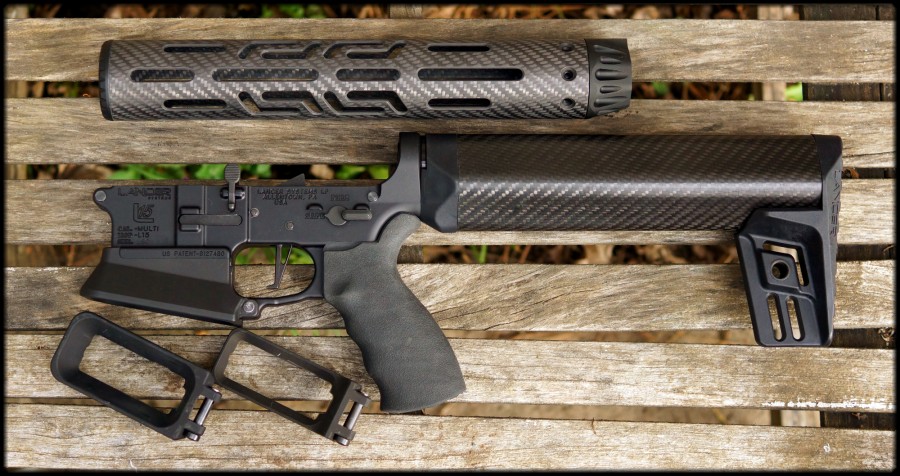
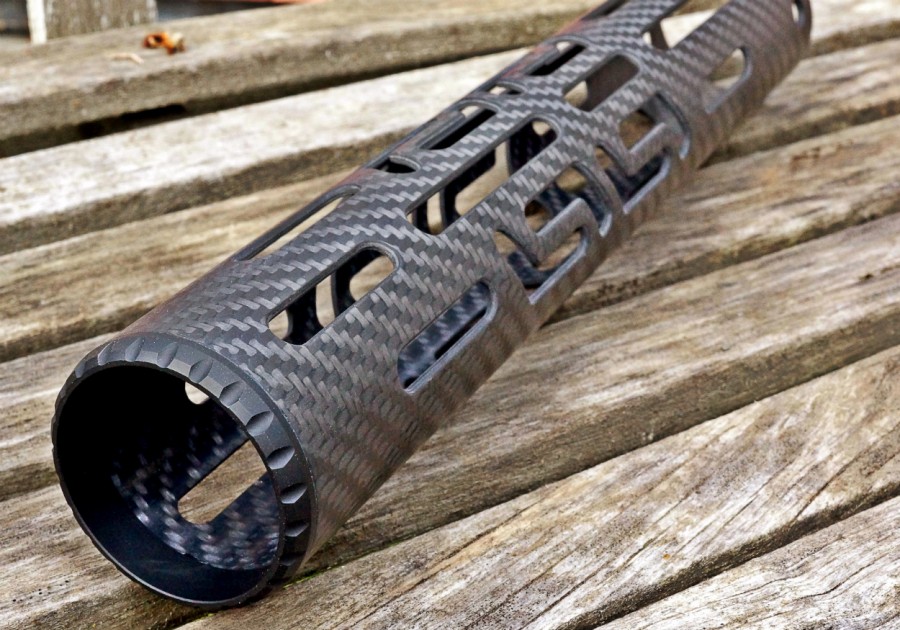
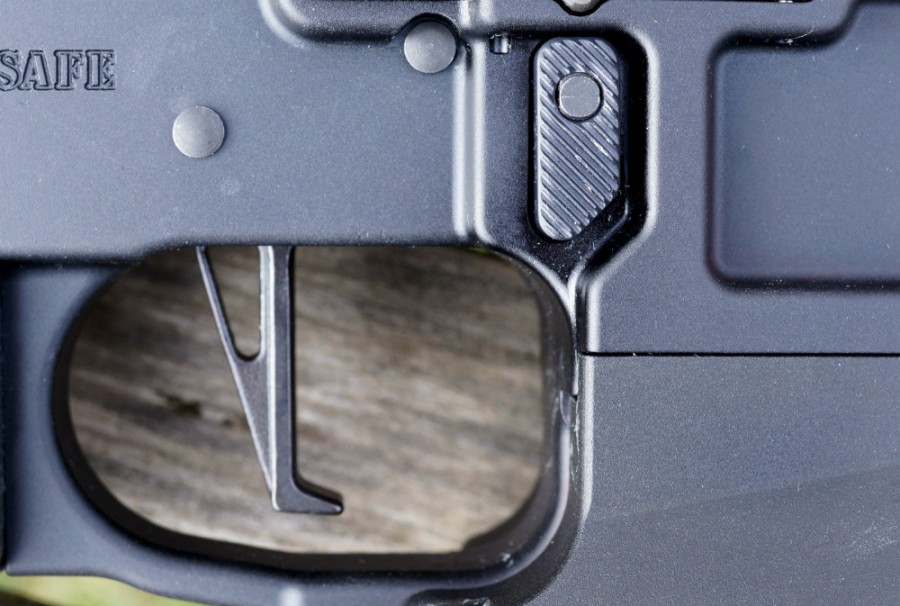
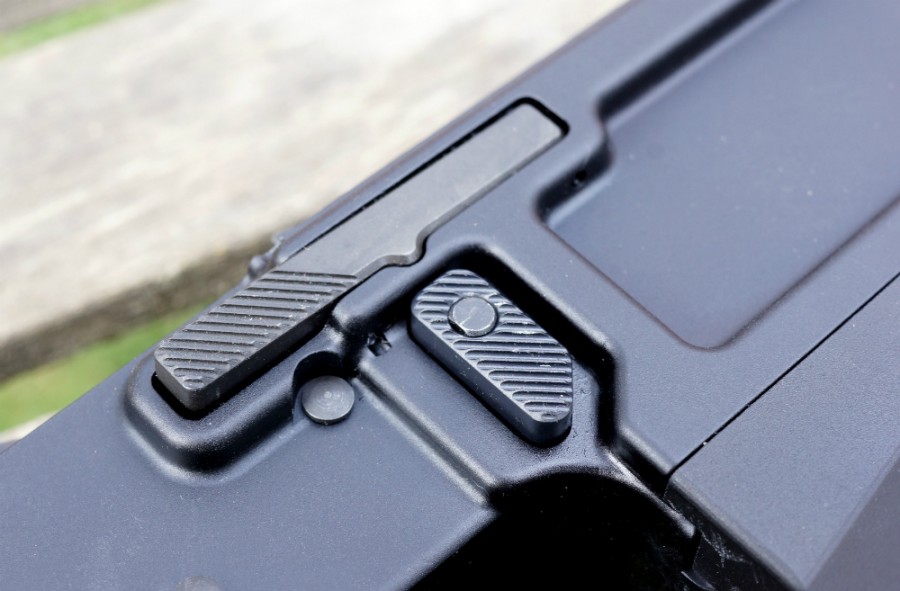
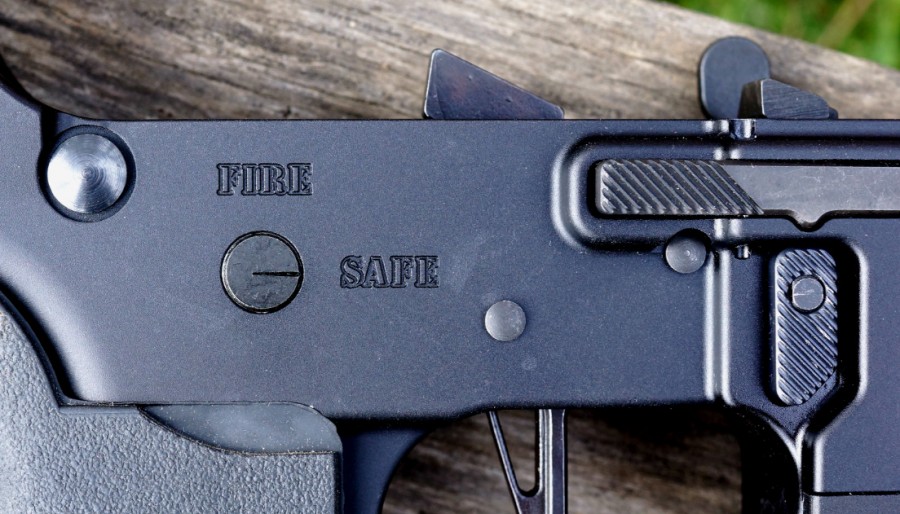
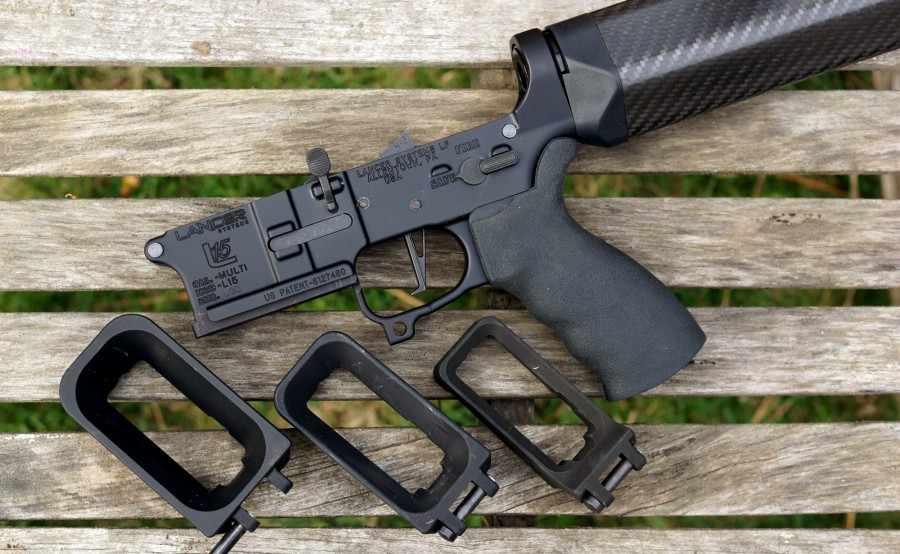

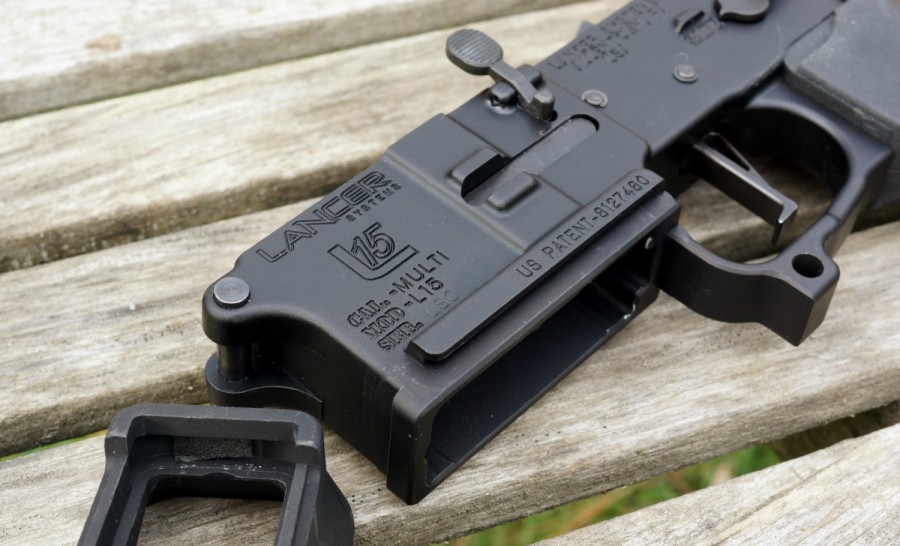
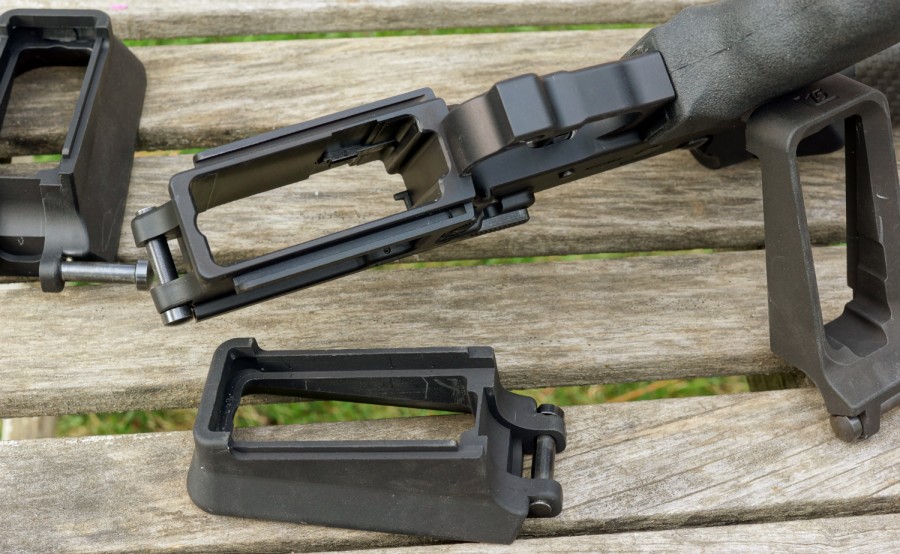
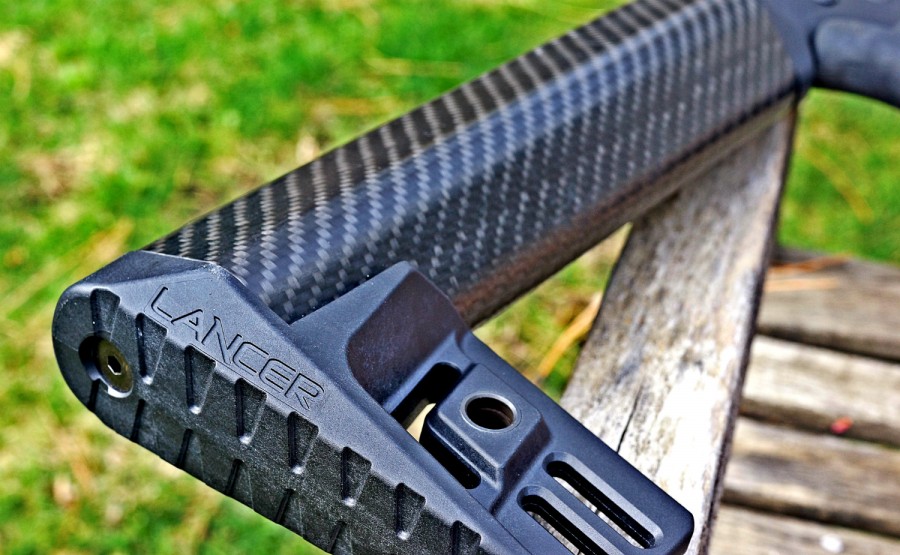
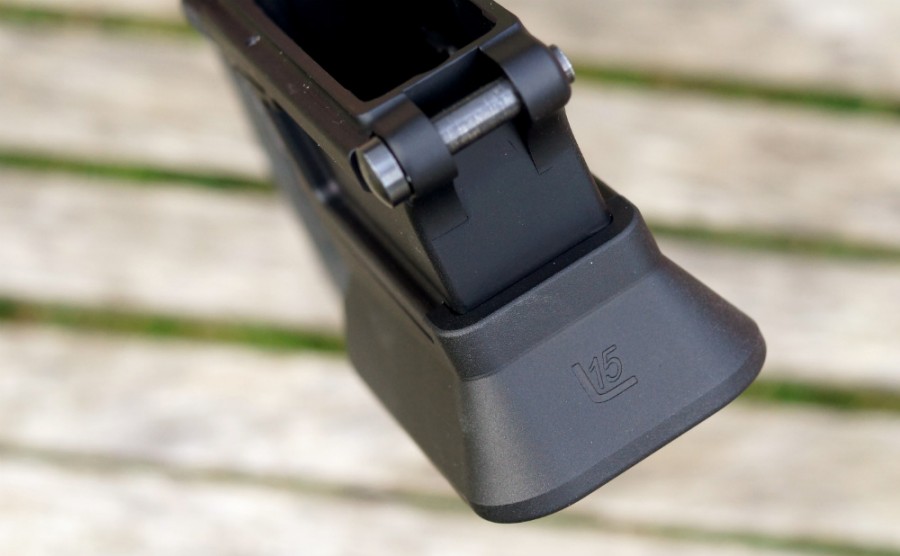
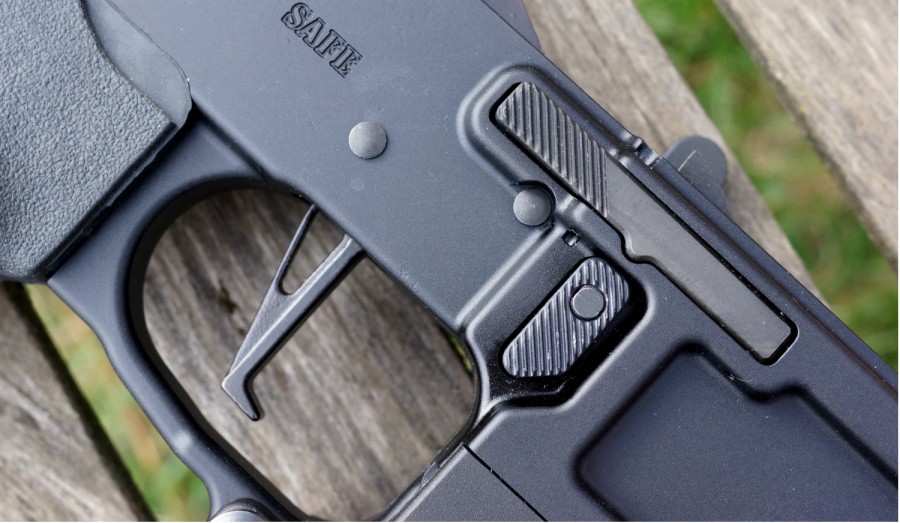
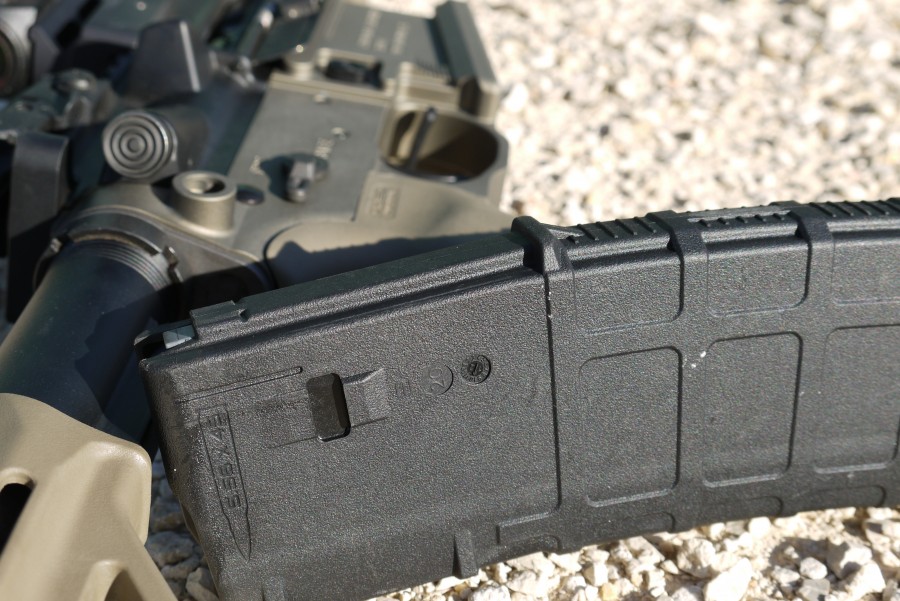



So….. Will a California Bullet Button fit into this lower?…..
Actually, if you check out their site and look at stripped lowers, complete lowers, or even complete rifles I do believe every single configuration is available with a Raddlock. (bullet button)
Interesting. The shape of their mag release and mag release button opening is so different looking…. Seems like there would be a huge gap around the Radlock – or any similar device or a standard mag release button for that matter.
Dude, seriously, check out the website haha. Here, I’ll help by linking a photo to the Raddlock itself. It’s custom made and looks the same as the normal mag release button. Well… it sticks out farther, assuming the photo is of it fully installed.
I’ve always wanted one of these lowers for 3-gun, but I’ve never found out if they will work with a coupled magazine. I use the Magpul couplers pretty often and it seems like the large magwell would interfere with the coupled mag. Thoughts?
Well… depends on how far apart the magazines are held by the coupler and which magwell you’re running. I just inserted a mag into the lower w/ the competition magwell installed, and you’d need at least 0.605″ space between the walls of the two magazines to clear the side of the magwell. The tactical magwell, which is still a big flare compared to mil-spec, would need about 0.431″ of separation between the mags.
Thanks so much for these measurements.
i do not understand why these companies still make partially ambi lowers. why not spend the extra 10 cents and 5 minutes of brainpower to throw in the mag release on the left side?
I don’t believe it was created for ambidextrous purposes. I think it was created to allow a right-handed shooter to more easily and rapidly drop the bolt upon changing magazines. Nothing to do with lefties. Considering the oversized magwells and such, my take is that the primary goal of the lower is to facilitate the most rapid magazine changes possible, and part of that is being able to drop the bolt as soon as the mag is inserted. On the L15, you can do it with your right hand trigger finger before your left hand is even entirely off of the magazine. Send the left hand straight to the handguard or wherever you grip, without having to stop at the bolt catch on the way there. It is actually faster and easier, in my experience. It took me a while to stop going for the bolt release with my left hand even though I already dropped it with my right hahaha, but once I got used to it I’ve really come to like it.
If you want completely ambi lowers look at Patriot Ordinance (POF), AXTS, or San Tan Tactical.
Also American Defense Manufacturing. I really liked their right-side bolt catch & release, and all controls are on both sides of the lower. Seen HERE from when we visited them at SHOT Show, and MAC just published a YouTube video on their rifles today.
Aluminum is aluminum. 250.00 for a stripped lower is just not acceptable.
It’s my understanding that there are only 2 or 3 forges in the U.S. that produce the rough forgings for AR-15 lower receivers. So, yeah, aluminum likely is aluminum. However, the process to go from that rough forging to a finished product leaves A LOT of work to be done. Machining is not machining and you’ll find variances in tolerances, strength, quality, appearance, etc. I’ve had a cheap lower where trigger pins didn’t line up properly and one of the holes had to be filed out to a just-slightly-oval shape before the second pin would go through. Loose or tight magwells, tool marks, uneven anodizing (typically dull or shiny spots)… seen it all.
I’m absolutely not one of those guys who believes you have to pay more to get quality or that top quality cannot be found at a very low price. Heck, the Velocity Triggers review from just last week is a great example. However, sometimes “you get what you pay for” is proven true, and I’ve seen and been burned by problems with cheap lowers and I’m very pleased with the quality of the Lancer L15 lower. The lower is an important part, and so many times I’ve skimped on parts at the initial purchase/build phase only to regret it a year later. The difference between $80 and $210 can be painful at the time of purchase, but is nothing spread over years of ownership. I wouldn’t use it on a trunk gun, but build a nice rifle, a go-to rifle, a competition rifle, and/or invest in a tax stamp for it, etc etc, and the relatively minor difference in that initial cost is long since forgotten.
BTW do you shake your fists at BMWs and say “steel is steel; paying more for a car than what a Honda Civic costs is not acceptable”? 😉
“BTW do you shake your fists at BMWs and say “steel is steel; paying more for a car than what a Honda Civic costs is not acceptable”?”
OOoo. Don’t, unless you’ve driven both. I drove a DIESEL loaner BMW, and was just astonished, cool car, really quick (faster than my long-ago 1971 Charger RT) smooth, quiet, and 43 mpg for one day’s driving, about 40 miles. I love my gas powered hot rod, but that diesel opened my eyes!
Their 3.0L turbo diesel is an amazing engine. Drove a 535d and it was awesome.
Jeremy, the one I drove was a 328d, the 4-banger 2 liter turbodiesel, I didn’t even know it existed. I was dazzled!
Firstly, thanks for the feedback, I feel involved now.
I have to say that I understand your direction and agree, mostly. I completely agree that the machining is an important part of lower construction and that is where the majority of the cost is. The reason for my comment was two fold:
1. This is a serious example of diminishing returns. Sure, you’re going to get a near 100% increase in quality by spending 80 dollars on a lower rather than 40. But spending around $80 is going to get you an excellent piece from a well known manufacturer. Hell, let’s call it $100. The extra $150 is a good portion of the way to an optic, or even better, a crap ton of ammo you can use to get proficient. The extra dollars above $100 pay for what I believe to be a couple of gimmicks, but that’s just me. The traditional set up of controls on an ar15 work just fine for me, and I can say truthfully that I’ve never wished my magwell was different. (As an aside, I shoot nitty-gritty defensive tactics courses and nothing really else. I don’t shoot long range, or competitions, so a different user may have different requirements. I’m not arguing that the lower shouldn’t exist, just that I don’t understand the price).
2. The stripped lower itself is probably the single best place on a rifle to cheap out. Hear me out: reliability, weight, accuracy, mounting options, balance, etc, are all determined by the upper receiver, trigger pack, and stock. If you’re going to spend a bunch of extra cash, spending on the barrel steel, the trigger, and a free-float hand guard are going to give you the most returns, not buying a name brand lower. Going on the same tact, that both my AR rifles are built for home defense and fighting, and nothing else, I have to say that although they’ve both malfunctioned, I’ve never had a trigger bind, or a lower crack at either the magwell or the buffer tube threads under a castle nut. Any reliability issues have always come from ammo or the upper.
I really liked the review from a literary perspective, so I don’t mean to be hyper-critical. I simply mean to say that I don’t understand spending so much money for a practical purpose on what is an essential part of a rifle, but one that doesn’t need a large amount of expertise to create.
To your aside, I would imagine that any AR15 rifle has more steel in it than either a BMW or a Honda now-a-days. 🙂
LOL. No worries, I like any and all comments (as you can tell, since I can’t help but respond).
At least in this case I feel like I’m paying for quality and features (whether those features are seen as gimmicks or not) rather than brand name. There are lots of completely and totally mil-spec lowers on the market that are ridiculously high-priced, IMHO, for no other reason than the logo that’s on them. In some cases they’re even machined by a 3rd party company that sells identical lowers with different logos for 1/3 of the price. That’s a waste. I just wouldn’t commit to the $200 and other hassles of registering any mil-spec lower as an SBR. A nice rifle that I’m basically owning indefinitely due to that non-recoverable $200? It’s gonna be on a Seekins lower, an L15, or something else that’s high quality and appealing to me aesthetically, etc… and even w/out the SBR thing, if I’m building a really nice rifle with a quality upper, barrel, BCG, buffer, stock, trigger, handguard, etc etc it seems really awkward to put all of that on a budget lower.
I agree with Jeremy. I’ve built an AR just to see how cheaply I could build it (A Jackson under $500 in 2012) and the parts were “meh”. Upper/lower fit was off, trigger was, at best, mil-spec (a compliment) and all in all, not an outstanding rifle. Since then, I started purchasing better quality parts because I have fallen into the “buy once, cry once” camp and want to get good parts from the outset. Will I pay for an AXTS lower receiver? Heck no, but I will buy Aero Precision, VLTOR, MEGA, BlackHole Weaponry barrels, and other quality parts because I’ve seen the headache of trying to make a crappy $20 gas block work when a $30 “brand name” one would have been perfect.
Nice review. I have been eyeballing one of these as the base of an SBR 300 BO build but there really aren’t a lot of reviews. I have recently been transiting to Lancer mags after experiencing notable pmag failures in training.
$250 is steep but may be time to pull the trigger.
I’m usually hesitant to outright say “you should buy this,” since it puts my neck out there for a product that’s out of my control and there’s so much that’s subjective, too. But… you should buy the L5 mags! They rock. Generally available for like $12-$14-ish in opaque and $19-ish in translucent.
I know Primary Arms and Bud’s Gunshop carry the Lancer lowers, but I’m not sure where else they’re available at retail prices. Bud’s may well be the lowest prices, actually, for the mags ($12.x) & lowers ($188).
Nice write-up, Jeremy.
If that happens to be a jug of powder on top of your safe, you may want to consider storing it on the floor.
That observation comes from me personally having had a housefire a few years back.
YMMV…
It is, yeah. Why would the floor be better than on top? Static electricity concerns? This is in my basement, in my cement-walled (bare foundation, really) dungeon of a home office haha. I could certainly move that jug onto the floor of the closet instead.
btw not actually a safe. It’s a WWII army hospital surplus medicine cabinet. Doesn’t lock, but it’s kinda cool and holds all of my expensive ammo plus shotgun shell reloading supplies. And dozens of gun & gear manufacturer decals on the front 😉 (the paint isn’t original anyway). Photo
In a fire, the ceiling is hotter than the floor. Boom.
Larry nailed it.
Heat rises in a housefire, it was rather interesting seeing the effects of it in person.
My particular fire was an eye-opener. In my laundry room on the wire shelves above the washer-dryer I had boxes and boxes of what I called ‘garage stuff’
Stuff like mineral spirits, carburetor cleaner, paints, Coleman lantern fuel (white gas), etc, etc, etc.
Finished laundry one day and then left to hang out with a friend. An hour later the apartment complex called and said your place is on fire.
According to the fire marshal, lint in the flexible dryer exhaust caught fire. Fire went up 3 feet to the boxes and boxes of flammable stuff. You can guess the rest. The fire marshal told me your clothes dryer was the number one cause of housefires.
If you have a plastic slinky-type dryer exhaust hose you might want to consider replacing it with a metal one. I lost a lot of stuff, but was just stuff. The complex maintenance guy saw black smoke pouring out of the eaves and used his master key to see if I was inside. I wasn’t, but the cat was and she hauled-ass outta of there. I was happy to take the trade of burnt stuff and smoke damage for her alive.
So that’s why I recommend storing flammables and ammo-powder as low as possible.
Your miles may vary…
Makes sense to me! Glad your kitty and all other living things were unscathed. Looked at my dryer now and it’s a metal vent and the stuff on the shorty shelf above/behind it is a gallon of liquid detergent and a gallon of bleach plus a big box of powdered detergent. I’ll move the jug o’ gunpowder to the floor or bottom shelf in the closet, or maybe just the floor underneath the reloading bench there… 🙂 …of course, I have like 6,000 rounds of ammo on storage racks on the other side of the office haha
Jeremy, all that ammo makes a smoke alarm unnecessary, know what I mean?
If you love to wear hoodies? so get this amazing Feel The Beat Hoodie Moreover, it has a hoodie-style collar with a pullover front closure and rib knitted cuffs to hold your wrist. All these amazing features make it one perfect casual outerwear to get compliments from your fashion friends. Discover now the best deals and amazing prices.
Comments are closed.